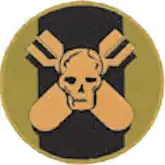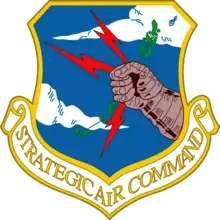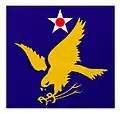527th Bombardment Squadron
The 527th Bombardment Squadron is an inactive United States Air Force unit. It was last assigned to the 379th Bombardment Wing at Homestead Air Force Base, Florida, where it was inactivated on 9 January 1961, when its parent wing converted to the Boeing B-52H Stratofortress..
| 527th Bombardment Squadron | |
|---|---|
 Strategic Air Command B-47 Stratojets | |
| Active | 1942–1945; 1958–1961 |
| Country | |
| Branch | |
| Role | Medium bomber |
| Engagements | European Theater of Operations |
| Decorations | Distinguished Unit Citation |
| Insignia | |
| 527th Bombardment Squadron emblem (approved 29 March 1943)[1] |  |
| World War II Fuselage code[2] | FO[2] |
The squadron was first activated during World War II. After training in the United States, it moved to England, where it participated in the strategic bombing campaign against Germany. The squadron twice was awarded the Distinguished Unit Citation for its combat actions. Following V-E Day, the squadron moved to Morocco, where it participated in the transportation of military personnel back to the United States until it was inactivated in June 1945.
The squadron was reactivated in 1958 as a Boeing B-47 Stratojet strategic bomber squadron, in response to Strategic Air Command's increased alert commitment. In 1960, it became non-operational, preparing for inactivation.
History
Activation and training
The squadron was first activated at Geiger Field, Washington in November 1942 as one of the four original squadrons of the 379th Bombardment Group. After initial organization, a cadre moved to Wendover Field, Utah to begin training as a heavy bomber unit with the Boeing B-17 Flying Fortress. Training was completed by early April 1943, and the ground echelon moved to Camp Williams, Wisconsin on 9 April, then proceeded to the Port of Embarkation at Camp Shanks, New York, where it boarded the RMS Aquitania for shipment to England in early May. The air echelon moved to Dow Field, Maine to ferry their Flying Fortresses via the North Atlantic Ferry Route, starting on 15 April.[1][3][4]
Combat in the European Theater

The air echelon of the squadron arrived at RAF Bovingdon by 24 April 1943, and remained there until 20 May, when it joined the ground echelon at RAF Kimbolton, which was to be its combat station for the remainder of its time in the European Theater of Operations. The squadron flew its first combat mission on 29 May, and focused on the strategic bombing campaign against Germany. This mission was the starting point for the first Distinguished Unit Citation (DUC) awarded to the squadron for its sustained actions through the end of July 1944. Targets included industrial sites, oil refineries, storage plants, submarine pens, airfields and communications centers in Germany, France, the Netherlands, Belgium, Norway and Poland. Targets included a chemical plant in Ludwigshafen, an aircraft assembly plant in Braunschweig, ball bearing plants at Schweinfurt and Leipzig, synthetic oil refineries at Merseburg and Gelsenkirchen, marshalling yards at Hamm and Reims and airfields in le Mesnil-au-Val and Berlin. The squadron received a second DUC for its attack on the FW190 aircraft factory at Oschersleben and the Junkers factory at Halberstadt on 11 January 1944. The programmed fighter escort encountered prohibitive weather, as did two of the three divisions making the attack. However, weather in the east was sufficiently clear that the Luftwaffe was able to assemble the largest interceptor force to oppose an attack for the preceding three months. However, the squadron flew into enemy territory without fighter escort to complete its mission.[1][3][5]
The squadron was occasionally diverted from the strategic bombing campaign to perform close air support and interdiction missions. It supported Operation Crossbow by attacking V-1 flying bomb and V-2 rocket launch sites. It bombed airfields, radar stations and other installations to prepare for Operation Overlord, the Normandy invasion in June 1944. On D-Day, it bombed defended positions just ahead of the Allied landings and struck airfields, rail choke points, and gun emplacements during the campaign that followed.[3]
During the Northern France Campaign, the squadron bombed enemy positions to assist ground troops during Operation Cobra, the breakout at Saint Lo on 24 and 25 July 1944. It attacked German communications and fortifications during the Battle of the Bulge, from December 1944 through January 1945 and bombed bridges and viaducts in France and Germany to aid the Allied assault across the Rhine, from February to March 1945.[3] The squadron flew its last mission on 25 April 1945.[4]
After V-E Day the squadron was detailed for the Green Project, which called for moving 50,000 American troops back to the United States each month.[6] The squadron moved to Casablanca Airfield, French Morocco, but in June, Air Transport Command decided to use its own, more flexible organization[note 2] for the project and the squadron was inactivated on 25 July 1945.[1][3]
Strategic Air Command
From 1958, the Boeing B-47 Stratojet Stratojet wings of Strategic Air Command (SAC) began to assume an alert posture at their home bases, reducing the amount of time spent on alert at overseas bases. The SAC alert cycle divided itself into four parts: planning, flying, alert and rest to meet General Thomas S. Power's initial goal of maintaining one third of SAC's planes on fifteen minute ground alert, fully fueled and ready for combat to reduce vulnerability to a Soviet missile strike.[7] To implement this new system B-47 wings reorganized from three to four squadrons.[7][8] The 527th was activated at Homestead Air Force Base as the fourth squadron of the 379th Bombardment Wing. The 379th Wing became nonoperational in October 1960 in preparation for conversion to the Boeing B-52H Stratofortress, and the squadron was inactivated on 9 January 1961.[1][8][9]
Lineage
- Constituted as the 527th Bombardment Squadron (Heavy) on 28 October 1942
- Activated on 3 November 1942
- Redesignated 527th Bombardment Squadron, Heavy c. 20 August 1943
- Inactivated on 25 July 1945
- Redesignated 527th Bombardment Squadron, Medium on 20 August 1958
- Activated on 1 November 1958
- Discontinued on 9 January 1961[1]
Assignments
- 379th Bombardment Group, 3 November 1942 – 25 July 1945
- 379th Bombardment Wing, 1 November 1958 – 9 January 1961[1]
Stations
- Geiger Field, Washington, 3 November 1942
- Wendover Field, Utah, 2 December 1942
- Sioux City Army Air Base, Iowa, 2 February–9 April 1943
- RAF Kimbolton (AAF-117),[10] England, 20 May 1943 – 12 June 1945
- Casablanca Airfield, French Morocco, 17 June–25 July 1945
- Homestead Air Force Base, Florida, 1 November 1958 – 9 January 1961[11]
Aircraft
- Boeing B-17 Flying Fortress, 1942–1945
- Boeing B-47E Stratojet, 1958–1961[1]
Awards and campaigns
| Award streamer | Award | Dates | Notes |
|---|---|---|---|
| Distinguished Unit Citation | 29 May 1943-31 July 1944 | Continental Europe[1] | |
| Distinguished Unit Citation | 11 January 1944 | Germany[1] |
| Campaign Streamer | Campaign | Dates | Notes |
|---|---|---|---|
| Air Offensive, Europe | 21 May 1943 – 5 June 1944 | [1] | |
| Air Combat, EAME Theater | 21 May 1943 – 11 May 1945 | [1] | |
| Normandy | 6 June 1944 – 24 July 1944 | [1] | |
| Northern France | 25 July 1944 – 14 September 1944 | [1] | |
| Rhineland | 15 September 1944 – 21 March 1945 | [1] | |
| Ardennes-Alsace | 16 December 1944 – 25 January 1945 | [1] | |
| Central Europe | 22 March 1945 – 21 May 1945 | [1] |
See also
References
Notes
- Explanatory notes
- Aircraft is Boeing B-17G Flying Fortress, serial 42-97462. The aircraft was repaired and returned to combat.
- Air Transport Command had reorganized its overseas units under the AAF Base Unit System in 1944. See Goss, p. 75 for the reasons for this reorganization.
- Citations
- Maurer, Combat Squadrons, pp. 632–633
- Watkins, pp.64–65
- Maurer, Combat Units, pp. 266–267
- Freeman, p. 253
- Freeman, pp. 104–105
- Heck, pp. 216–221
- Schake, p. 220 (note 43)
- "Abstract (Unclassified), History of the Strategic Bomber since 1945 (Top Secret, downgraded to Secret)". Air Force History Index. 1 April 1975. Retrieved 4 March 2014.
- Ravenstein, Combat Wings, pp. 204–205
- Station number in Anderson.
- Station information in Maurer, Combat Squadrons, pp. 632–633, except as noted.
Bibliography
![]() This article incorporates public domain material from the Air Force Historical Research Agency website http://www.afhra.af.mil/.
This article incorporates public domain material from the Air Force Historical Research Agency website http://www.afhra.af.mil/.
- Anderson, Capt. Barry (1985). Army Air Forces Stations: A Guide to the Stations Where U.S. Army Air Forces Personnel Served in the United Kingdom During World War II (PDF). Maxwell AFB, AL: Research Division, USAF Historical Research Center. Archived from the original (PDF) on 23 January 2016. Retrieved 28 June 2017.
- Freeman, Roger A. (1970). The Mighty Eighth: Units, Men and Machines (A History of the US 8th Army Air Force). London, England, UK: Macdonald and Company. ISBN 978-0-87938-638-2.
- Goss, William A. (1955). "The Organization and its Responsibilities, Chapter 2 The AAF". In Craven, Wesley F.; Cate, James L. (eds.). The Army Air Forces in World War II (PDF). Vol. VI: Men & Planes. Chicago: University of Chicago Press. LCCN 48003657. OCLC 704158. Retrieved 17 December 2016.
- Heck, Frank H (1955). "Air Transport, Chapter 8 Traffic Homeward Bound". In Craven, Wesley F; Cate, James L (eds.). The Army Air Forces in World War II (PDF). Vol. VII: Services Around the World. Chicago: University of Chicago Press. LCCN 48003657. OCLC 704158. Retrieved 17 December 2016.
- Maurer, Maurer, ed. (1983) [1961]. Air Force Combat Units of World War II (PDF) (reprint ed.). Washington, DC: Office of Air Force History. ISBN 0-912799-02-1. LCCN 61060979. Retrieved 17 December 2016.
- Maurer, Maurer, ed. (1982) [1969]. Combat Squadrons of the Air Force, World War II (PDF) (reprint ed.). Washington, DC: Office of Air Force History. ISBN 0-405-12194-6. LCCN 70605402. OCLC 72556.
- Ravenstein, Charles A. (1984). Air Force Combat Wings, Lineage & Honors Histories 1947–1977. Washington, DC: Office of Air Force History. ISBN 0-912799-12-9. Retrieved 17 December 2016.
- Schake, Col Kurt W. (1998). Strategic Frontier: American Bomber Bases Overseas, 1950–1960 (PDF). Trondheim, Norway: Norwegian University of Science and Technology. ISBN 978-8277650241. Retrieved 27 July 2015.
- Watkins, Robert (2008). Battle Colors: Insignia and Markings of the Eighth Air Force in World War II. Vol I (VIII) Bomber Command. Atglen, PA: Shiffer Publishing Ltd. ISBN 0-7643-1987-6.


